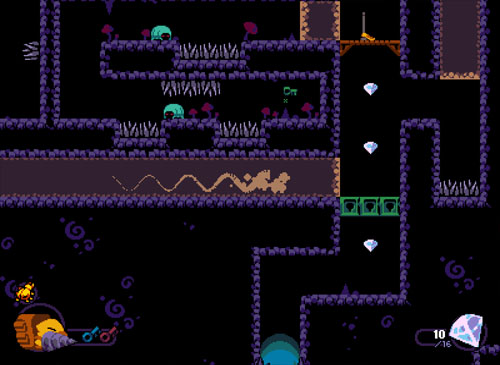A game by Team Bugulon for PC, originally released in 2021.
Tailspin is a drill-based platformer with environmental puzzle elements. You take on the role of a canary wearing a backpack and wielding a large handheld drill, which it uses to plumb the depths in search of treasure. The subterranean world is filled with valuable gems, and even more rare golden scarabs, but also many lurking creatures, traps, and other dangerous obstacles.While the canary is incapable of flight, it does have quite a few skills at its disposal. It has a very high jump, a drill-based air dash, and the ability to drill quickly through the dirt. Drilling is only possible to the left, right, or down, so the players must pay attention to the environment to ensure that they don’t miss an opportunity to grab collectibles.
A more advanced environmental navigation technique comes in the form of a drill bounce. By drilling into any solid surface, the canary is bounced quickly backwards, spinning as it goes. The player can use this bounce to perform wall jumps, triangle jump up narrow shafts, or bounce to high platforms by drilling downwards. The player must use all of these techniques to complete the levels, but scarabs (and some gems) are generally placed off the beaten path, requiring a keen eye and keener platforming skills to reach.
The goal of each level is to simply make it to the exit, which is always placed somewhere along the bottom of the stage. Stages tend to have some verticality to them, but there is quite a bit of variety in the level designs, consisting of large open levels, tight vertical levels, and more traditional horizontal platforming levels. There are multiple gems in each level, but only one scarab, and collecting them is entirely optional (except to unlock the final area).
Simply reaching the end of the level isn’t terribly difficult for the most part. The real challenge – and the meat of the gameplay – comes from seeking out every gem in the level, and making your way to the scarab. The HUD displays the number of gems collected versus the total number, and the level select interface indicates the levels in which the player has collected every gem or every scarab. It’s also worth noting that levels can be replayed at any time, and the player is not required to collect every gem and the scarab in a single run.
In some cases, the player must collect keys to open the path forward, but these expectations are sometimes subverted in fun ways, as collecting keys instantly removes any keyhole blocks of the corresponding color. Removing these blocks may open the player up to plunging into spike traps, allow enemies to attack, or even prevent the player from jumping up a vertical surface. One entire level is built around taking the longest and most difficult route to ensure that no keys are collected.
The canary has generally slow movement, which supports the more thoughtful navigation of the environment required to collect everything. Rarely are players pressed for time, but there are a few challenges where they must move quickly to overcome challenges. For instance, the third area introduces stationary enemies that disappear when drilled, but they come back to life after a few seconds, potentially blocking the player’s path. Another level features a row of enemies slowly moving downward, and the player must run quickly through the level to escape them.
Most enemies can be killed by jumping on them or drilling through them, although some spiked enemies can only be drilled, and some enemies are immune to your attacks altogether. You also have to be careful as drilling propels you forward a bit, so drilling into an enemy while standing on a platform could send you over the edge… and the drill becomes temporarily unavailable (as indicated by a color change) each time it is used.
In addition to enemies, the player must sometimes contend with moving platforms, trampoline mushrooms, bottomless pits, and spikes, although the drill can also be used to bounce safely away from spike traps if the player is quick enough. Some of the longer or more complex levels offer checkpoints, and there can be a fair distance between them, but the short level lengths mean that players won’t be covering too much of the same ground if they are killed. And since collecting is optional, players are given the freedom to bypass some challenges and still move on to the next level, with the freedom to return any time they like.
Some later levels really rely on players to make use of every tool at their disposal, and the final world takes things to a whole new level, presenting entirely new challenges, tougher gameplay, and more bottomless pits. But in order to reach this final challenge area, players must collect at least 14 scarabs out of the 18 total, so this is truly a challenge reserved for the most skilled players… and a place for those players to put their skills to the test.
The game offers basic but pleasant tile-based visuals and some cute enemies, with much of the protagonist’s charm relayed by way of its profile image in the HUD, which reacts accordingly to drilling, spinning, or smashing into things. There are 24 levels in total, and two possible endings, and the action is accompanied by a pretty jazzy soundtrack.
2D CRED
Tailspin was developed by a collection of creators calling themselves Team Bugulon, with the credits consisting of online handles. The team has participated in numerous game jams over the years, and this game was developed for Ludum Dare 48, which had a theme of “deeper and deeper”. The credits include programming by Sarn and Oroshibu; art by THX, SnakeBlock, Attfooy, and Shrombus; concept art by Bubonto; additional level design by Squp; and sound and music by Mista Jub, with everyone on the team credited with game and level design.























0 comments:
Post a Comment